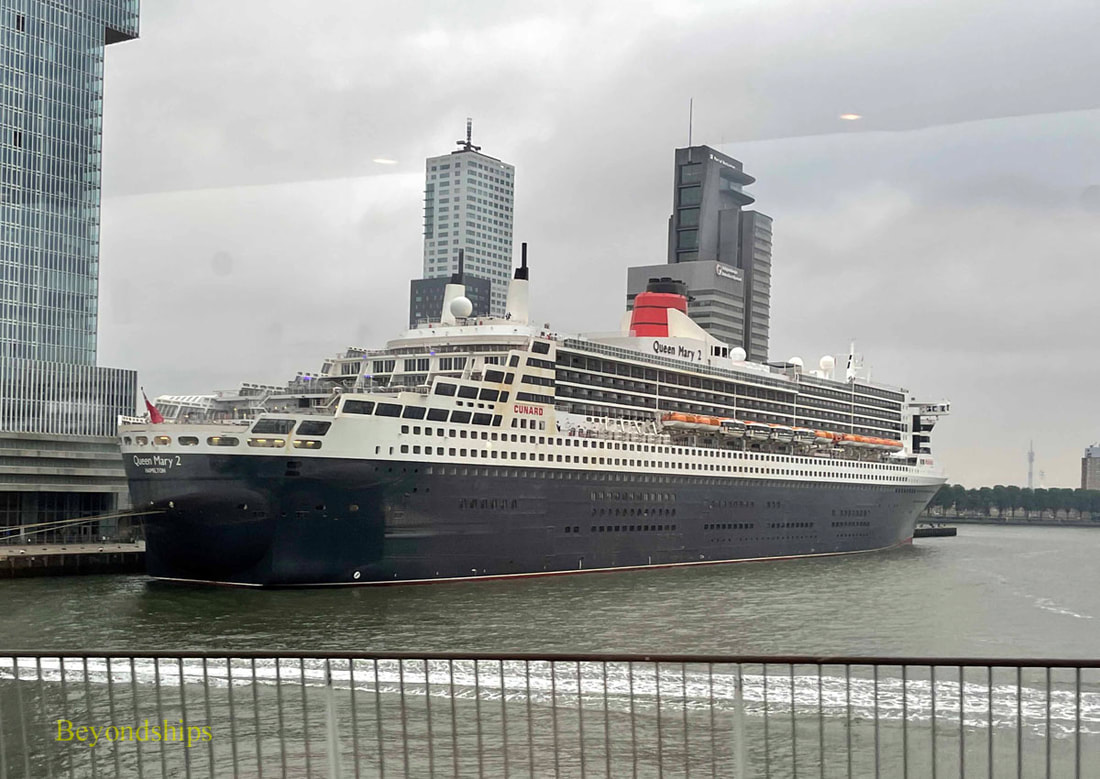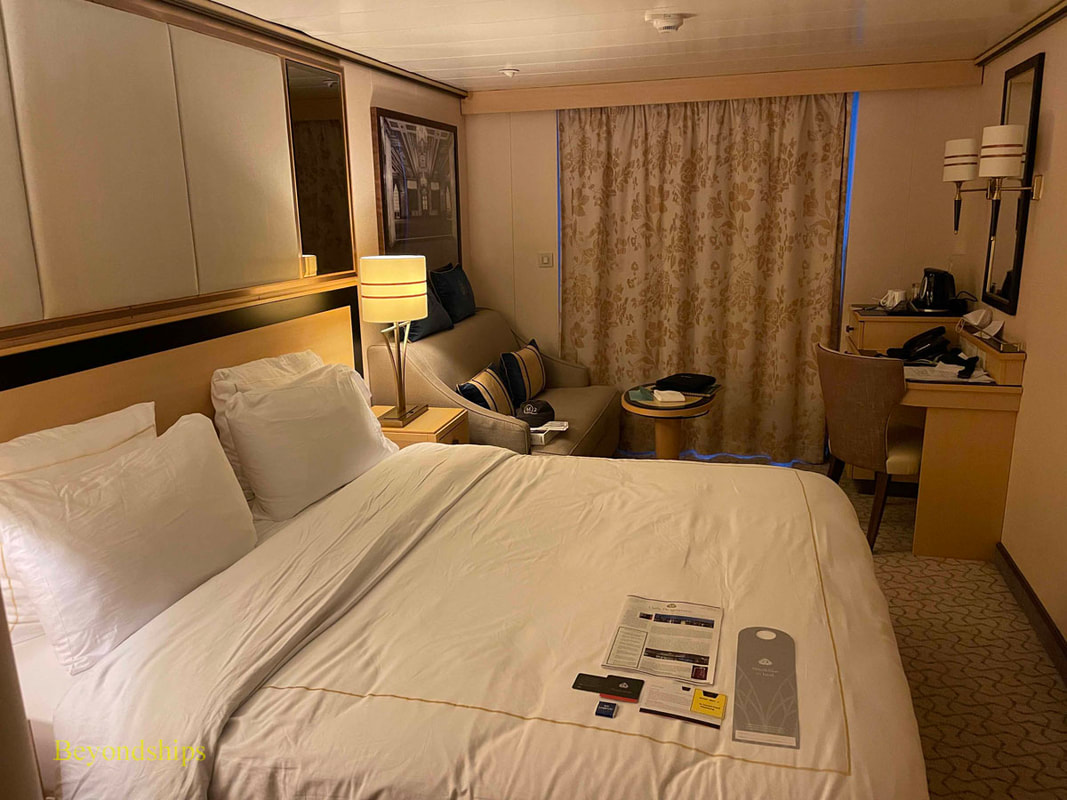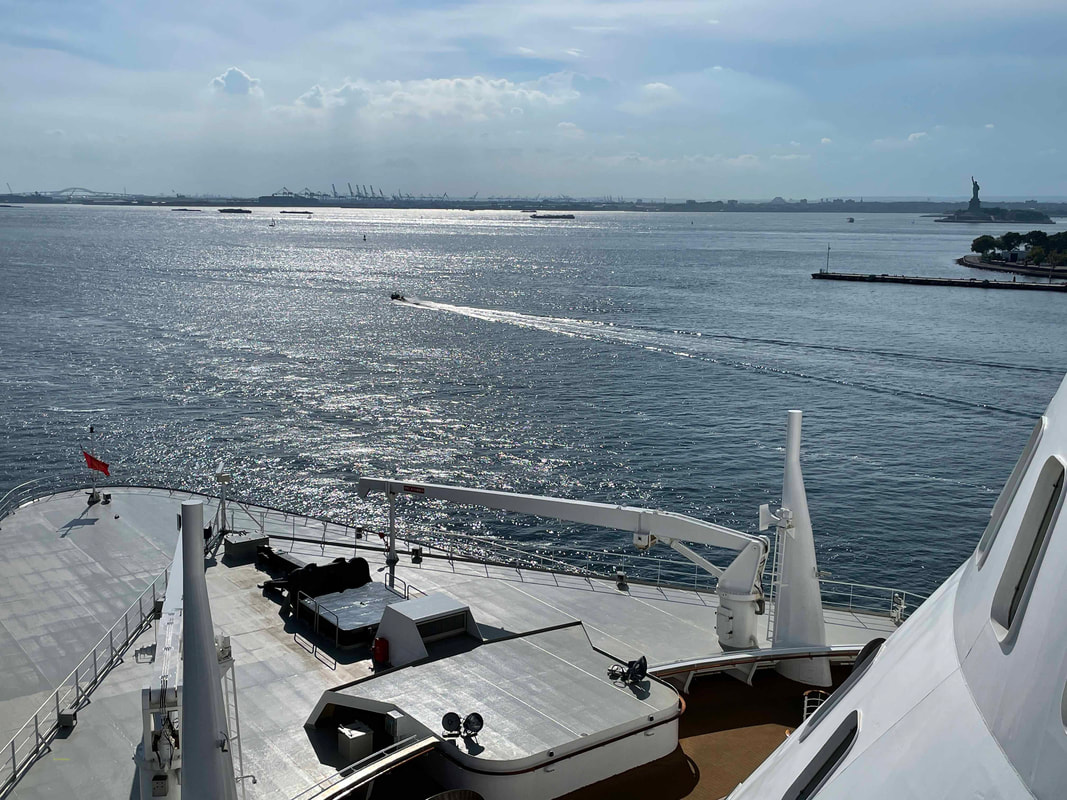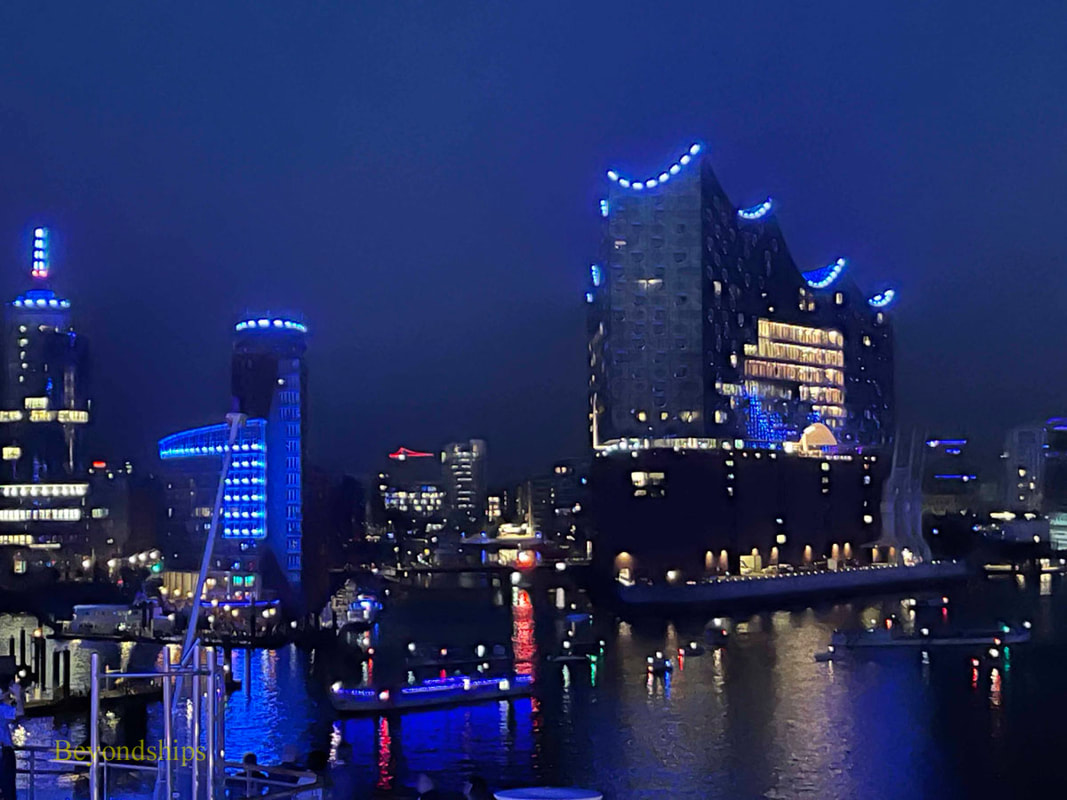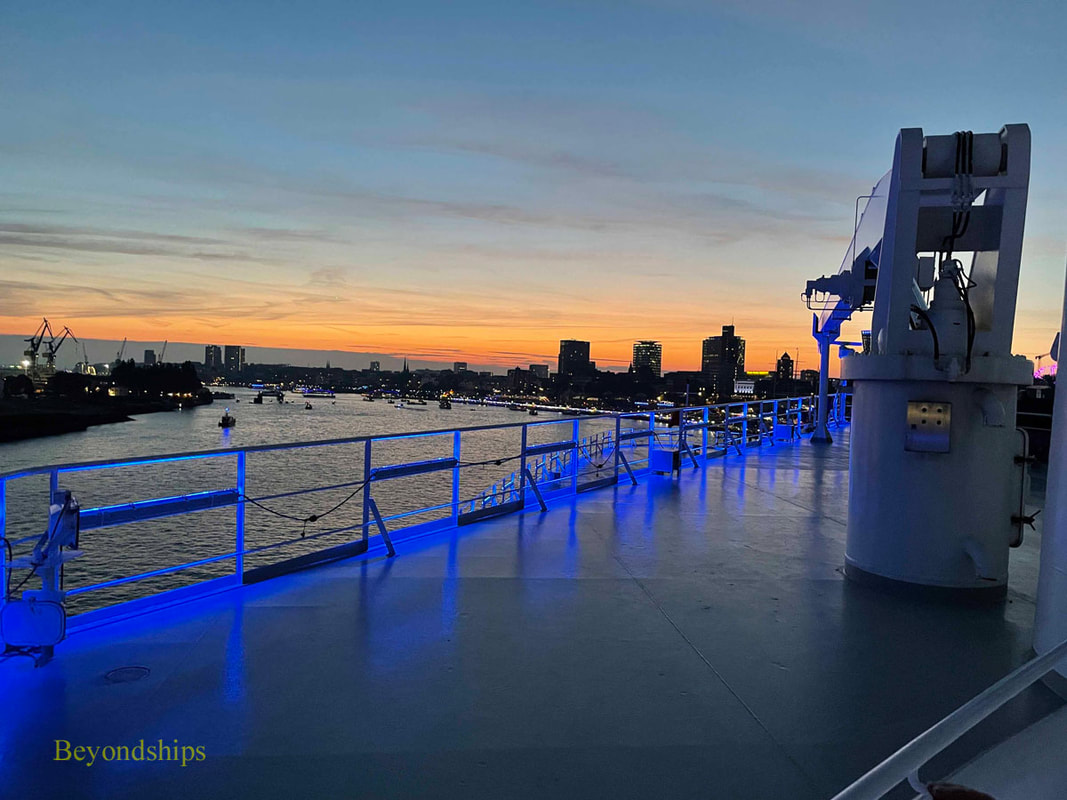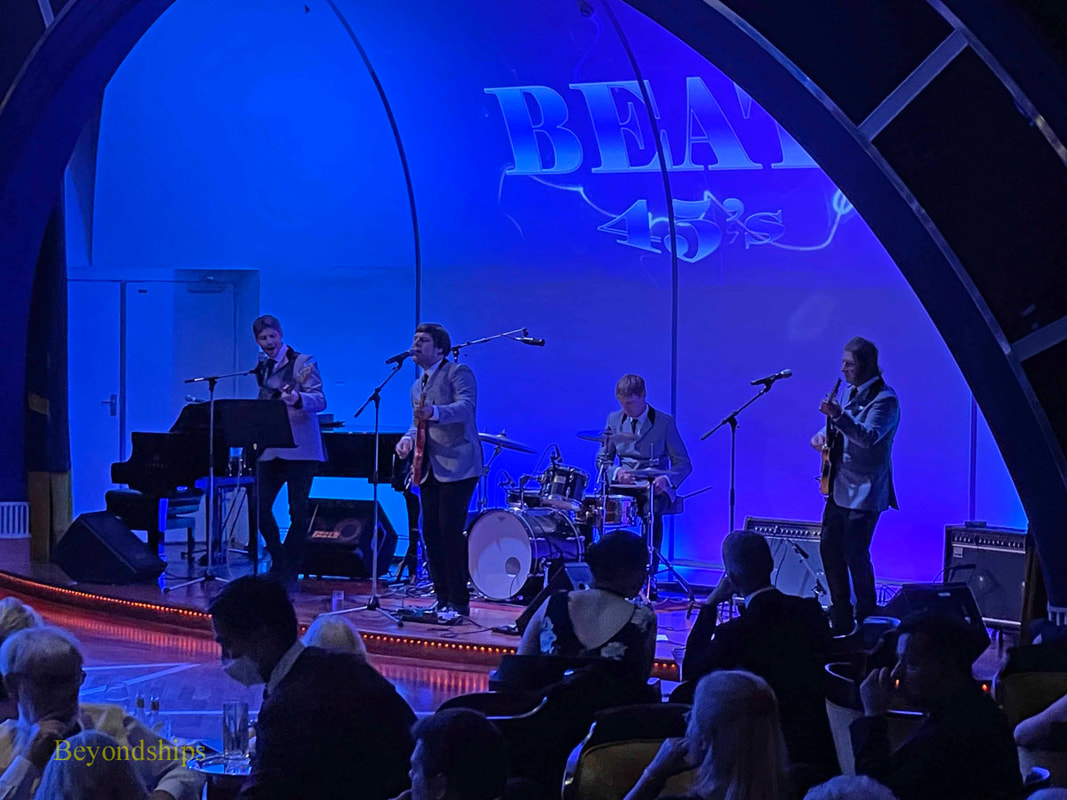|
This was a 9-day cruise round-trip from Southampton, England with calls at: Hamburg, Germany; Zeebrugge, Belguim; and Rotterdam, The Netherlands. Although designed as an ocean liner, Queen Mary 2 can also serve as a cruise ship with ease.
An icon in Germany As the itinerary suggests, this cruise was structured to serve QM2's large following in Germany. The Germans love QM2. While only a handful of people turn out to watch the ship each time when she is in New York, literally thousands of Germans turn out just to look at QM2 sail by during her calls in Germany. You can always expect a sizeable number of Germans on a transatlantic crossing and when there is a call in Germany on the itinerary, Germans are often the largest nationality aboard the ship. On this cruise, QM2 called in Hamburg twice. This enabled passengers to make a round-trip from Hamburg and many Germans took advantage of this arrangement. However, a sizeable number of Germans made it a longer voyage by sailing round-trip Southampton and quite a few came aboard for a short two night sailing from Southampton to Hamburg. It is not immediately obvious why so many Germans love QM2. Germany builts some of the best modern cruise ships but this ship was built in France using American money. Cruising is popular in Germany and Germany has two thriving large cruise lines TUI and AIDA. However, those lines offer a quite casual cruise experience rather than the more formal British-style experience offered by Cunard where tradition is honored. Since there is no real connection between QM2 and Germany, it must be something about QM2 itself that attracts the Germans. QM2 is technologically unique, a modern ocean liner with all-steel construction and the ability to travel at speeds no cruise ship can match. But more importantly, it is the combination of history and atmosphere that seems to attract the Germans. QM2 is the successor to the great liners of the 20th century. Yet, she offers a modern travel experience that is sophisticated but yet easy for 21st century travelers to live with. On her second call in Hamburg on this cruise, QM2 was the centerpiece of a harbor festival. As part of this festival, the tall buildings in Germany's second largest city were bathed in blue light in the evening. QM2 also had a blue glow from a special set of lights that had been placed aboard for the occasion. She sailed up the Elbe River to the center of the harbor as music played from shore. It is estimated that some 200,000 people turned out to watch. The center of so much attention, it was a magic moment aboard QM2. Cunard returns this affection by taking steps to accomodate its German guests. The language of the ship remains English but there is a German-speaking hostess and announcements are made in both languages. There are also German translations of the menus and the daily programs as well as lectures in German and German entertainment. However, German passengers often avoid these because they want an authentic Cunard experience and because they want to interact with people from other cultures. This does not mean that QM2 turns into a German cruise ship on such cruises. There were many British and some Americans on this voyage. As noted above, the ship's language remained English. The ship continued to provide the same type of activities, entertainment and dining that it offers on transatlantic crossings and on North American cruises. The ports One thing that differntiates a cruise from a crossing is that ports of call play a major role in the cruise experience. Passengers can explore the ports on their own, take one of the excursions offered by the ship or just relax aboard ship. For those who like to explore on their own, Cunard offered shuttle buses in each of the ports. In Hamburg, the bus ran between the cruise terminal and the Hamburg city hall in the center of the city. In Zeebrugge, the bus went to a nearby railroad station. In Rotterdam, the bus went to the Markethall, once again in the center of the city. There was no charge for this service and the buses ran on a frequent basis. Cunard also offered an array of shore excursions in each port. Reflecting the fact that Cunard attracts more sophisticated passengers these included trips to cultural sites such as art museums as well as the more typical surveys of the tourist attractions of each city. Separate excursions were offered in English and in German. The tour office aboard operated efficiently and in a friendly manner. For those passengers who were combining the cruise with either the preceding or following transatlantic crossing, QM2 offered excursions in Southampton to Windsor Castle, the New Forrest and to Stonehenge. I chose the latter tour because the timeless atmosphere at Stonehenge makes it worth seeing more than once and because I always discover something new about it each time I go. The drive through the beautiful English countryside on a summer day is also an attraction. The schedule of onboard activities continued while the ship was in port albeit at a slower pace. There were no lectures but recent movies played in the large movie theater/planetarium and several trivia quizes were offered. Unlike most ships, the main dining room remained open for lunch while the ship was in port. |
The accomodations
For this voyage, I had a sheltered balcony cabin. These cabins are different than the typical cruise ship balcony cabin because the balcony is cut out of the steel of the hull. While it may be an illusion, I get more of a feeling of privacy in these cabins than in the more typical glass-front balcony cabins on the higher decks. I also like to hear the sea as the ship cuts through the water. I had sailed the crossing preceding this cruise in an inside cabin. If you are going to combine a crossing and a cruise or just do back-to-back sailings, it is preferrable to book the same cabin for both voyages since you do not have to pack and unpack in the middle of your journey. However, for this cruise, Cunard was offering a very attractive rate for sheltered balcony cabins so I decided that I would switch cabins in Southampton. Cunard made the process very easy. I did not have to go through the check-in process in the cruise terminal at Southampton. Rather, I simply went to the guest services desk and they gave me a new room card in Southampton. I then called the housekeeping department and they said to leave my bags in the old cabin. When I returned from my shore excursion, the bags were in my new cabin. My inside cabin on the crossing was quite comfortable. However, the sheltered balcony cabin felt more spacious. In addition, there is something very nice about having natural light in a cabin and being able to open the door to let in the sea air. Also, the natural and man-made things that you can see looking out both in port and at sea are often wonderous. The dining and service were essentially the same as on the preceding cruise (see review). In short, the food was good and the service respectful and efficient. The entertainment was similar to but not quite the same as on the crossing. One difference was that this cruise featured performances by the Beatles Celebration, a Beatles tribute band. Inasmuch as the Beatles spent part of their early career in Hamburg, this band appealed to both English-speaking and German guests. The band played a concert in the Royal Theatre and a dance party in the Queens Room ballroom. Fcusing primarily on the early music of the Beatles, the band successfully evoked the atmosphere of the Beatles era. Along the same lines, another tribute band, Beat 45, performed for another dance party in the Queens Room. Instead of limiting themselves to the music of the Beatles, this band played music from several of the 1960s British Invasion bands. Purists may object that including the Monkees “Day Dream Believer” was improper as the Monkees were an American creation but Davy Jones who sang the lead on the original recording was British. In any event, the passengers enjoyed the show. Disembarkation Before the pandemic, Cunard passengers were given a specific baggage tag and were asked to wait in the public areas for that color baggage tag to be called. This was done so that the crew had more time to ready the cabins for the passengers who would be boarding later in the day. On this voyage, passengers were asked to wait in their cabins until their baggage tag color was called. Not only was this more comfortable but it was a better anti-Covid safeguard since it avoided having large groups of people waiting in the same area. It also did not seem to delay the disembarkation process inasmuch as the ship finished disembarkation at about the same time that it usually did pre-pandemic. As in the past, guests who were illing and able to carry all of their baggage ashore were allowed to do so. Such guests were allowed to leave the ship shortly after he ship's arrival since they do not have to wait for their baggage to be unloaded and placed in the cruise terminal. This was the first time in my more than 50 voyages on QM2 that the ship berthed at Southampton's Mayflower Terminal. However, from a passenger's perspective, there did not seem to be much difference between disembarking there than at the Ocean Terminal, the Queen Elizabeth 2 Terminal or the City Terminal. While it is possible to walk to the train station or into downtown Southampton from the Mayflower Terminal, it is located in an industrial area and one has to be aware of the commercial traffic. In sum, this was a very enjoyable cruise and the harbor event in Hamburg served as a reminder that QM2 is a special ship. |
Above and below: Hamburg and QM2 in blue light.
Above: Beat 45 playing in the Queens Room.
|
Cruise review - - Cunard Line - - Queen Mary 2 - - European Cruise - Summer 2022
